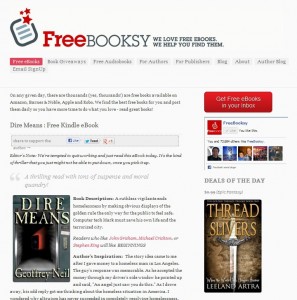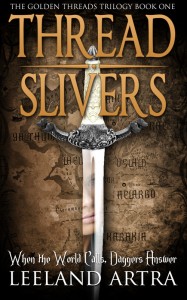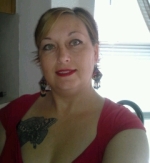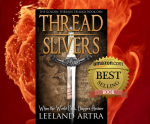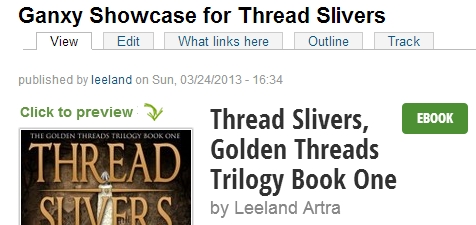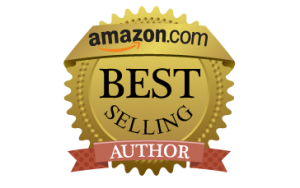 Nick Stephenson interviewed me on how I became an Amazon Bestselling Author in the first month of my publication of Thread Slivers for his blog. It was fun and he did a fabulous job here is the article copied from his site. It is titled “Magic, Mysticism, and Marketing – success stories with author Leeland Artra” (you can still see it directly on Nick’s site at http://bit.ly/YnrYEJ).
Nick Stephenson interviewed me on how I became an Amazon Bestselling Author in the first month of my publication of Thread Slivers for his blog. It was fun and he did a fabulous job here is the article copied from his site. It is titled “Magic, Mysticism, and Marketing – success stories with author Leeland Artra” (you can still see it directly on Nick’s site at http://bit.ly/YnrYEJ).
 Magic, Mysticism, and Marketing – success stories with author Leeland Artra
Magic, Mysticism, and Marketing – success stories with author Leeland Artra
Posted on March 13, 2013 by Nick Stephenson
Today, we’ve got quite a treat in store for all you literature fans, fellow authors, and those of you who stumbled across the site by accident while searching for cheap prescription medicine and articles about Justin Bieber (there, I got those keywords in). Don’t go anywhere, you’ll want to read this: Leeland Artra, author of the mind-bogglingly successful Golden Threads trilogy (book one, Thread Slivers is available now) is joining us to tell us a little bit about his book, and the tactics he used to market his novel. Budding authors, fantasy readers, and internet marketing pros should take heed – Mr Artra pulled a metaphysical rabbit out of his hat and managed to get his first novel into the top 2,000 titles on Amazon (that’s the top 1%, people) within weeks of its release – which is practically unheard of for a first-time writer. Want to know how he did it? Read on…
Hi Leeland – thanks for joining us today for a quick peek into your work, and I’m sure some scandalous details about your personal life…
Hello Nick – That sounds both exciting and a little scary. I am thrilled you asked to do this. I’ll do my best. As to scandalous afraid I don’t have anything so serious to admit to. I say this. Many people believe in reincarnation, and it seems I am proving that belief, except all in one go. Being an author is literally my fifth career. They say that real life isn’t like video games, and I agree, but I admit I have seriously hit the reset button twice now with reasonable success. I don’t want to do it again. It is a lot of work to start over.
No salacious secrets you want to share with the world? Oh well, it was worth a shot. On to the real questions, then. Your bio states that you have spent a good deal of your professional life as a software engineer – what made you decide to take the plunge and start writing?
I started role playing in the 1970s and loved it. I developed complex backstories for all my characters. Later I started running the games and I always had fun creating complex side plots happening around the player party. My friends loved this as the world wasn’t static and they bumped into these other plots on and off. Repeating characters, events cascading off of other events and even more popular was when the non-player-characters had to alter their plans based on the players’ actions. Many of my friends encouraged me to write novels, especially when they saw the volumes of materials I created around all the gaming.
It was something I kept saying I wanted to do. But, education, career, family, and real life issues kept taking priority over writing my stories. In 2012 I decided I needed more than just a role playing session every few months for my fantasy fix and decided to give writing a serious try. I spent about three hours every day for four months in intensive study of everything I could on how to write a sellable fiction novel. Then I pulled all my notes and materials for my universe going all the way back to 1982. With the new knowledge I picked an important point in the history and developed an outline for a trilogy. I created some new characters and adapted old ones so I had a complete set of believable people to get through the story arc. I then set out to make writing my full time career. I have been working it like a second job ever since. Things are turning out better than I hoped. I believe I might be able to make the transition in a few more years.
So, tell us a little bit about your Golden Threads trilogy – and how does book 1 (Thread Slivers) fit into the grand scheme of things?
The trilogy is set in a universe I created specifically to be continuous. This makes it interesting in that it isn’t an alternate reality or strange dimension. The timeline for the series runs right through today and beyond. There is a pseudo-scientific explanation for how things got from time A with physics P1 to time B with physics P2 and so on. The few friends I have confided the whole story to have said it is interesting and believable, even fantastically possible. A lot of the ideas used for the book come from various beliefs I had or have on why some things are the way they are. A lot of it is also based on theoretical physics ideas I have read about.
The trilogy is set at a critical moment for the universe. It is set 15,000 years after “the great migration,” which was when ‘magic’ became more than just a barely measurable energy. It is also 5,000 years after an immense disaster which caused all of the countries, gods, and people to agree to the creation of the Mage’s Guild to prevent such a disaster again.
The trilogy’s main plots are based on the tragic love story of Shar-Lumen and Kliasa as well as the coming of age stories of a unique pair of elite mercenaries Ticca and Lebuin. Shar-Lumen, is using his vast knowledge and empire of elite warriors to destroy the world that allowed his love, Kliasa, to die. A semi-renegade wizard experimenting with forbidden temporal sciences discovered that the world is to be destroyed. Numerous attempts have been made to save the world which was initially thought to be a natural disaster. Over many attempts the major powers have discovered that the destruction is not natural. Shar-Lumen’s plan is so good every attempt to even discover what causes the end of the world fails.
The trilogy is about the fifth and final attempt to save the world using very desperate measures carefully executed to hopefully expose the danger far earlier than ever before and to prevent any temporal paradoxes, which would also cause the end of the universe. The desperate measures include not warning any of the perceived key people, and making it seem the key players are not even a threat. In the first book everyone is reacting to unexplained events they don’t understand. In the second book the key people finally begin to piece together who they really are and what is happening. In the third book is the surprising conclusion where we learn if the world was saved or not. This progression explains the titles which follow the states of threads from slivers, to strands, and finally to skeins. In the series threads of time, threads of plots, threads of information are slowly put together by the characters hence Thread Slivers, Thread Strands, and finally Thread Skein.
When the trilogy finishes there will be lots of places to go. There will be a lot of prequel material as well as follow on stories with the same characters. I guess that is a bit of a spoiler since it reveals the world will be saved. I haven’t decided what the next project will be, so fans have a chance to prod me into a favourite direction. Maybe I’ll have a poll on Facebook or Goodreads.
One of Leeland’s Sales Banners for Thread Slivers
Your first book has been praised in the same sentence as Asimov’s foundation series – in terms of the level of detail that goes into creating your characters’ universe. Where do you think the line is drawn between too much, and too little detail in a book?
I was shocked to see that comparison. Isaac Asimov is an author I truly admire and I have read almost everything he wrote. I loved the foundation series and to be compared to that amazing set of stories was a real thrill and honour.
On the question of details, I did a lot of reading on this. I also analysed many of my favourite trilogies. There are some amazing authors like Isaac Asimov, Timothy Zahn, Piers Anthony, and many more who I studied how they described new races and places. I also spoke to other authors like Elle Casey, Melissa Foster, and Lindsay Buroker on this topic. The advice and examples were not exactly in alignment. There is a lot of room for individual style. The general goal is to provide enough description that readers can form a mental picture and no more. This has two excellent outcomes, one that the stories flow faster without a lot of descriptive details, and two that each reader will form their own mental picture of the scene and characters; this makes the story more engrossing for readers as it is their own imagination that fills in the details.
In contrast to the general descriptions it is important there is a complex world with a believable timeline of events. This is where my stories are surprising people because this is a complex universe with a very complex history. There are people who live and work in it being affected by these events. There are super powers in the form of governments, gods, powerful individuals, and even some computer AIs. Each super power has its own personality, goals, rules, and conduct. All of these elements come into play in this trilogy and get in each other’s way.
The comparison to the foundation series I believe comes from the clues I have in the first book for readers to form a good picture of the reality. The clues when assembled show this is a world which was built or adapted for and by a handful of races one of which was humans from our Earth. There was or is vastly superior technology which has been forgotten by most for an as yet unexplained reason. Magic is a real energy source that is not only present but dangerous like radiation to humans; magic was not significant on Earth, but is needed for other races to survive. It is hinted that the near medieval setting was planned for or at least expected by the past governments for unknown reasons.
Let’s talk a little bit about marketing. I’ve seen that you have a presence on Facebook, Twitter, Goodreads, author forums, and a variety of other places. Of all the marketing avenues you’ve tried so far, which do you think is the most effective at getting readers to check out your work?
I started looking into this very early, before I had even written the first line of the manuscript for the first book. I owned a consulting business for many years and was already well versed with marketing effectiveness and necessity. The main thing to understand is you cannot just be annoying and yell “buy my book” to everyone and expect good results.
Twitter was new, and prior to my starting to write I pretty much had decided I didn’t like it. Facebook was a little bit too much of a time waster so I only had a minimal presence on that. I didn’t even know about Goodreads or many of the other forums.
Like everything else I studied it all again from the stand point of ‘How can I effectively use this to meet new readers?’ I read and generally already knew that books only sell one way: people telling their friends to check the book out. From my business experience I knew that advertising doesn’t convince anyone to buy anything, all it does is cause people to remember you make gizmo-A when they decided they want to by a gizmo-A. The goal is to constantly remind your prospective clients that you make gizmo-A better frequently so that when they do make that choice you are right there in their valuable mind space.
I started watching successful indie authors on how they used social tools like Facebook and Twitter. I then joined in some conversations with them whenever I had an opinion or something to share. I made sure to never inflate my answers, or jump in just to jump in. Over six months I became known to many great authors and developed my friendship with them which I still put effort into today. I followed them around as they showed me where they went and how they did stuff. This is how I found Goodreads.com, WorldLiteraryCafe.com and learned effective ways to market without being annoying on Facebook, Twitter, and Google+.
In late November 2012 I realized I had managed to get to know a lot of authors but not many readers. I started looking for ways to connect with readers. In truth the way to do this was the same. All it takes is to hunt for the people, say hello, be willing to chat with them, and listen to what they say. It is all about meeting people and getting to know them one person at a time. I tried to make the coming book release fun for all and I really enjoyed the banter I had with everyone. They must have started talking about Thread Slivers with their friends becauseThread Slivers as had wonderful sales results in its first month out.
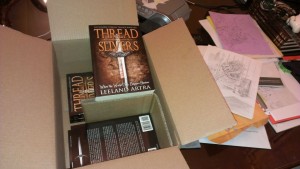
A lot of authors will tell you that social media don’t sell books. Do you agree?
That is a fuzzy question. I agree that in general social media does not sell the book. But, social media is where you get people to talk about your book so that their friends will consider it if in the mood. So social media is a marketing tool to let people know that you have a book out, what others are saying about it, and what it is.
Just blasting a tweet “Thread Slivers is available now! Buy it at http://amzn.to/WNK81n” over and over every day won’t sell anything. If that was all sent I’d find myself with no followers fast. On the other hand having a support network of friends and authors regularly tweeting stuff like ‘RT @LArtra Read more #fantasy! THREAD SLIVERS “incredibly hard to put down” #BestSelling #eBook http://amzn.to/WNK81n’ which says what it is, what is being said and who it is from gets people to go check it out. I doubt many people will buy it from just that. But, a lot do check it out, because that is a tracked link which tells me how many times it was clicked per day. I can count how many tweets were sent on a day like that vs. how many times it was clicked.
As a software engineer, you must be used to measuring and managing a lot of data. What tools do you use to measure and manage your book marketing (eg link tracking, databases, analytics software, etc)? Are there any tools you wish existed, but that currently don’t?
Yes I use a number of tools. Before the book was released I tracked my success based on the Facebook metrics for the Golden Threads Trilogy page at http://on.fb.me/UQV9Sz which has a lot of interesting details. I also used Google Analytics which is tied into my blog site at https://lartra.com/ that provided all the metrics I needed. I also used Bit.ly because their links are tracked as well as you can see if someone else made a bit.ly link to the same page. Before publication it was all about impressions, referrals, and organic spread of things like sneak peeks etc.
After publication I still use all of that but I also use the eBook tracker at http://tracker.kindlenationdaily.com/ which is very interesting. You can hook into any books available and watch for trends.
The hardest part about all this information is being patient enough to let things cook for a few days at a time and then making only one change. It is important to not make lots of changes all at once because then you cannot tell which changes worked and which ones did not. It is very hard to resist the temptation to fiddle with things like price and advertising.
Have you tried any paid advertising? If so, which sites would you recommend? If not, any plans to do so in the future?
Yes I have used paid advertising to great success. Again the main goal with marketing is to make people who might be interested in buying your book aware of it; which really means getting on their to-be-read list. This is only done via their friends or by being recognizable. Hence a distinctive, interesting, and professional book cover is critical. Then make sure they see that cover all over the place. So that when they do go to buy the next book to read when they see your cover they think ‘oh ya everyone is talking about that one.’
There are a lot of sites that will charge a ton of money for very little return. This is why tracking things using the tools above is important.
What I have used that has worked, meaning a measurable bump in sales right after it starts and a falloff in sales once it stops, is a WorldLiteraryCafe new release campaign, a WorldLiteraryCafe MediaBuzz campaign, a series of Facebook ads, and a FreeBooksy Bargain Book Campaign. These are all inexpensive and have given a large enough boost in sales to pay for the advertising. The effectiveness of using all of them (at different times and with a week break between) is a layered approach that gets Thread Slivers in front of people over and over again, but not so often as to be highly annoying.
I have refused to pay some sites because their rates were so far above the above list I felt they were trying to take advantage of indie authors.
As a self-published author, it’s all down to you to handle quality control. How important do you think the editing, blurb writing, and cover design process is in producing a product that will sell successfully? How do you handle your own quality control?
I think quality is immensely important. For Thread Slivers there were two amazing paid professional editors (Alexis Arendt at http://wordvagabond.com/ and Kitten Jackson at http://www.kittenkjackson.com/), an awesome work-for-hire paid professional art company (Streetlight Graphics at http://www.streetlightgraphics.com/), and a paid professional formatting company (also Streetlight Graphics, seriously these folks are great). I also ran Thread Slivers through a wonderful writing coach (C.S. Lakin at http://www.cslakin.com/) and got some surprising professional critiquing feedback (sorry I’m not allowed to say who). I also sought out professional marketeers (just friends, no links sorry) to help write and critique the blurb.
Thread Slivers has professionally drawn maps, 16 custom sketches which went through many iterations to get right, and went through formatting a few times to get it exactly right. The cover went through 16 separate revisions before we were all happy with it. I had to remind myself a couple of times that when you seek out and hire a professional marketeer who knows the industry you should listen to their opinion. For Thread Slivers I did this and it shows.
I want my books to always meet a very high bar for quality. Every single book is potentially the first book someone may see of mine. Therefore, I want every book to be as good as I can make it. You only get a first impression chance once.
Finally – what’s the main reason that readers should go right ahead and buy your book? This is not the time to be modest!
Thread Slivers is a top-notch fantasy/sci-fi novel, which was 20 years in the making and represents thousands of hours of work. It is an epic fantasy with a cast of hundreds, dozens of intertwining plots and even more events happening around the world that touch on the characters. But, why listen to me when the reviews and professionals who have read have said so much:
“I actually got so involved with reading it that I forgot I was supposed to be editing it!”
“An epic story I will read again and again trying to follow all the threads.”
“A solid story worth reading.”
“Loved reading this book.”
“Incredibly hard to put down.”
“I highly recommend it to anyone into fantasy.”
“Thread Slivers has exciting twists & turns, lots of battles, magic & new found courage”
“Good read, real good story, and a great escape.”
“Can’t wait till the next book.”
“An EPIC, as detailed as Asimov’s Foundation Trilogy.”
“This is a great start to a trilogy.”
“The continuous flow of action and inter-action kept me glued.”
“Vivid plot details & exquisite turns of imagination…easy-to-read, fast-paced & humorous style”
“An excellent story that hints at a well-developed world with a rich history, I cannot wait for the next book! Pay attention, it’ll surprise you.”
“Dammit Leeland hurry up with the second book!”
Thanks Leeland – it’s been a pleasure having you round.
Nick says: so, there you have it – the secret to selling a bucketload of books. Actually, hang on, it’s not so much a secret. If you want to emulate Leeland’s success, the advice is clear: write a great book, invest in pro cover design, editing, and formatting. Prepare a marketing plan that covers the 4 Ps of marketing (don’t know what that is? Read my posts here and here), and don’t be afraid to spend money on advertising; If you’re doing everything properly, the ad-spots will pay for themselves many times over.
If you like the sound of Leeland’s epic Golden Trilogy series, you can check out the first book, Thread Slivers, here (just click the cover, or the text link below):
Huh? I’m a bestselling author! You can find all my books on Amazon (http://author.to/LArtra)!


